Two
Stretched Skulls
Anamorphic Games and the Memento Mortem Mortis
Their only experience of humanity was a crowbar coming at them down a steel corridor.
—G-Man, Half-Life 2: Episode 2
Realism is a terrible, terrible design trope.
—Gabe Newell, “On Productivity, Economics, Political Institutions and the Future of Corporations”
Peering out from a canyon cradled between two mesas, a series of striated buttes punctuate the Southwestern landscape. Fat tubes of rich, red earth jut into the sky as if extruded along the sharp contrasts of a height map. Below, specular highlights and ray-traced reflections define a river’s surface—a sheet of frozen ripples sinking beneath banks of rust-colored sand. Atmosphere occludes the horizon where a purple, pixelated smear articulates the union of red and blue. The colors are odd, the shadows are off, and the entire scene is slightly stretched like the painted panorama of a museum diorama, Hollywood backlot, or chapel ceiling. An anamorphic image posing as perspectival space, this imaginary New Mexico unfolds into a cruciform that wraps around the geometry of a skybox. The smell of ozone and petrichor of the desert is replaced by the odor of a freshly unboxed graphics card or stack of memory sticks in anti-static wrap. On a contemporary computer, the sharp cliff faces and stiff bipedal figures that populate the foreground are rendered at a much higher resolution than those twenty-year-old, interpolated buttes in the background. Patrolling the cliff’s edge, a lone marine from the Hazardous Environment Combat Unit (HECU) idles outside the Black Mesa Research Facility; the contours of his crisp uniform stand out against the anti-aliased skyline. In Half-Life (1998), low-poly models float in the middle of a New Mexican-themed box—a cube composed of six seamless 256 x 256 pixel textures. Wisps of cream-colored clouds, pre-baked maroon shadows, and the rippling bump map of the teal water paint a strange picture. This New Mexico may as well be Mars (see Figure 2.1).
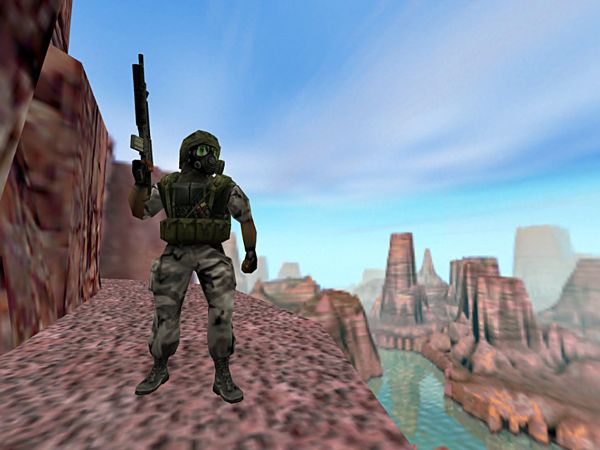
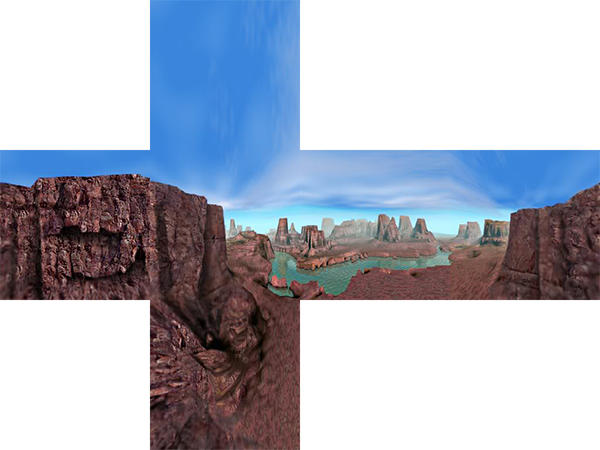
Figure 2.1. A computer-generated New Mexican vista (top) is the result of a series of six seamless textures (bottom) that wrap the skybox to produce the background of Half-Life.
On the surface of Mars, NASA’s Curiosity rover carries a piece of New Mexico with it. Cut from some of the densest lava on Earth, a smooth basalt disk installed as part of the rover’s alpha particle X-ray spectrometer (as distinct from mass spectrometers) is the control variable for extraterrestrial experiments (NASA 2012). A terrestrial tabula rasa chemically contrasting the Martian soil, basalt is used to calibrate the half-lives of materials on Mars. One such anomalous material, a 1 x 5.5-foot rock formation, was found on the 53rd Martian day of NASA’s first rover mission in 2004 and nicknamed “Sandia” after the Sandia-Manzano mountain range in New Mexico (NASA 2004). When characterizing the New Mexican landscape at the beginning of Alien Phenomenology, Or What It’s Like to Be a Thing, Ian Bogost (2012, 1) writes:
When the weather is clear, the Sandia Mountains to the east of Albuquerque drip the juices of their namesake fruit for a spell each evening, ripening quickly until the twilight devours them. . . . In the hollowed out Manzano Mountain, the United States Armed Forces Special Weapons Command once stashed the nation’s largest domestic nuclear weapons repository, some 2,450 warheads as of the turn of the millennium.
From NASA to SETI to the Trinity nuclear test site and the landfill where Atari abandoned its surplus E.T. the Extra-Terrestrial (1982) cartridges (among other things),[1] New Mexico offered Bogost (2012, 1) a “childhood of weird objects.” In Alien Phenomenology Bogost (2012, 17) channels Graham Harman’s “Object-Oriented Ontology” and Levi Bryant’s “Democracy of Objects” in order to evoke a New Mexico in which all objects are assigned the “same ontological status.” From “the guilty Manhattan project physicist, the oval-headed alien anthropomorph, and the intelligent celestial race” to “the scoria cone, the obsidian fragment, the gypsum crystal, the capsicum pepper, and the propane flame,” Alien Phenomenology not only attempts to place all objects on equal ontological footing, but in doing attempts to decorrelate the human experience of the world from the larger “world of things” (Bogost 2012, 3).[2]
Somewhere in terrestrial New Mexico, no doubt near the abandoned missile testing grounds and corporate landfills of the twentieth-century military entertainment complex, is another kind of complex buried beneath the red sand: Black Mesa Research Facility, the setting of Valve Corporation’s first game, Half-Life. From mesas on the surface of Mars in Doom (1993) to the Black Mesa Research Facility in Half-Life, both the graphics and gameplay of first-person shooters (FPS) are predicated on the mechanics of perspectival rendering.[3] In these games, aiming and firing a gun stands in for the point-and-click interface of a computer mouse. Ballistics are reduced to the path of a ray traced from the first-person camera to the geometry of the game’s polygonal environment.[4] But, in the same way that the objects in Bogost’s New Mexico infinitely withdraw from the domain of experience, the red planets carefully rendered in first-person shooters are always, in some way, just out of reach (or out of sight). Even before Gordon Freeman pushed the G-Man’s anomalous materials into the anti-mass spectrometer in Lab X and triggered the resonance cascade linking planet Earth and dimension Xen, Black Mesa Research Facility was full of xenomorphs.[5]
Half-Life begins with Freeman’s commute from the Level 3 dormitories to the Sector C test labs and control facilities via the company’s automated tram. As he arrives late to work on that fateful day, a public service announcement calmly intones, “The time is 8:47 a.m. Current topside temperature is 93 degrees with an estimated high of 105. The Black Mesa compound is maintained at a pleasant 68 degrees at all times” (Valve 1998). Twenty-seven years old with a Ph.D. in theoretical physics from MIT, the player’s silent cipher must wait. Unable to exit the tram, for the next five or so minutes[6] Freeman is subjected to a series of ominous vignettes occurring behind the scenes at Black Mesa that foreshadow the events of Half-Life: a security guard banging on a tunnel door, white-coated scientists scuttling along rusted catwalks, a concrete pipe swinging at the end of a chain, a nuclear missile in mid-transport to some unknown launch site, autonomous quadrupedal robots performing industrial labor (and sometimes blocking the tram), a black Apache helicopter on a landing pad in the New Mexican landscape, and the mysterious G-Man straightening his tie in an adjoining tram above what appears to be the neon green goo of a reactor leak. As scenes of industrial disarray and bureaucracy run amok pass by, it’s no wonder Gordon is late to work. The tram is designed not for transportation but for sightseeing—for seeing sight. It operates as a camera obscura or anatomical theater, a lens with which to view the alien and alienating visual technics of Half-Life itself.[7]
A compelling but nonetheless linear experience, Half-Life is also on rails. The infamous tram ride not only showcases snippets of the various levels the player will soon traverse, but, in its attempt to render a seamless experience in real time, foregrounds the underlying interface metaphors and logic of control that structure the game. Even after stepping onto the platform at Sector C, Freeman is still propelled from corridor to corridor although designer, player, and even the G-Man conspire to obfuscate the linear mechanisms of algorithmic control in order to present the illusion of an immersive, interactive, and open world. At the end of the game, Freeman need not leap into the portal to dimension Xen; he is already embedded in a distorted, inaccessible, and irresolvable universe of everyday-yet-eldritch objects. That is not a nuclear missile, that is not an Apache helicopter, that is not the G-Man, and that is not a pipe (or crowbar); rather, these are demonstrations of real-time diegetic storytelling, scripted in-game events, and seamless level design. As Gordon Freeman discovers, Black Mesa is in the business not only of exploiting alien technology for monetary and military gain, but also of inventing the idioms that inspired cinematic shooters like Battlefield (2005–), Modern Warfare (2007–), and Black Ops (2010–). Gabe Newell (Tufnell 2011), the co-founder of Valve, remembers that “Half-Life in many ways was a reactionary response to the trivialization of the experience of the first-person genre.” In his 1998 review, Ron Dulin (1998) attests that “a major goal in any game is to create the illusion of reality, a fact that is especially true for first-person shooters. The whole point of the genre is to put you, literally, in the role of the protagonist . . . [and Half-Life is] the closest thing to a revolutionary step the genre has ever taken.” Or so Black Mesa would have us think. Despite the long-held desire for perspectival immersivity, there is always an anamorphic remainder lying along the monorail or the steel corridor of the first-person shooter.
If anyone can outdo the alien and alienating inventions of the Black Mesa Research Facility, it is Aperture Science, Inc. First introduced in Valve’s Portal (2007), the corporate rivalry between Aperture Science and Black Mesa manifests through both in-game and out-of-game advertising and propaganda reminiscent of Apple’s “Get a Mac” campaign, which pitted Justin Long’s “I’m a Mac” against John Hodgman’s “I’m a PC” from 2006 to 2009 (see Figure 2.2).[8] Aperture Science’s most popular product, central to the gameplay in Portal, is the Aperture Science Handheld Portal Device, or “portal gun.”[9] In Half-Life 2 (2004), Black Mesa’s Zero Point Energy Field Manipulator, or “gravity gun,” is transformed from a piece of equipment designed to handle anomalous materials to another perspectival technology in the hands of Gordon Freeman. Cinder blocks, oil barrels, and saw blades are first pulled to the player then positioned in front of the camera before each object can be projected along a vector traced from the player’s virtual camera-eye to the geometry of the gamespace. Extending the perspectival operations of the gravity gun beyond the rays traced from various weapons, the Aperture Science Handheld Portal Device represents a game mechanic that not only references Half-Life, but makes a metagame about first-person shooters as a genre.
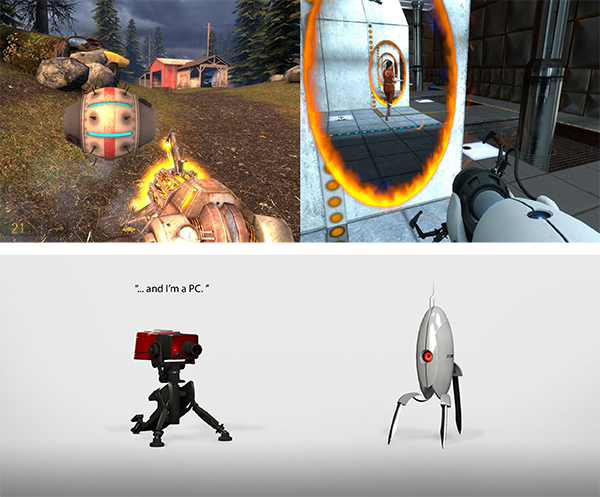
Figure 2.2. Whereas the gravity gun follows in the footsteps of Doom’s BFG 9000, the portal gun adopts the aesthetic of Apple computers (top). This Mac-versus-PC–esque rivalry is made explicit in Valve’s teaser images promoting their digital distribution service, Steam, once it was released for Apple computers (bottom).
Whereas Half-Life attempts to present an immersive and naturalistic 3D space in which both the physics and scenery mimetically reference a New Mexican landscape and follow the conventions of filmic realism (even while bunny-hopping from asteroid to asteroid in dimension Xen), Portal articulates a different model of space. At the beginning of the game, another silent protagonist, Chell,[10] wakes up from a “brief detention in the relaxation vault” to discover herself a lab rat in a series of experiments run by GLaDOS, the artificially intelligent unreliable narrator of Portal (Valve 2007). In order to complete the AI’s twenty test chambers and escape the Aperture Science Computer-Aided Enrichment Center, the player must use the portal gun to produce “intra-dimensional gates” that connect the various planes of polygonal space. Enter through one portal, exit through another one, or, as GLaDOS explains, “momentum, a function of mass and velocity, is conserved between portals. In layman’s terms: Speedy-thing goes in, speedy-thing comes out” (Valve 2007). Beyond momentum and movement, these wormholes also function as screens or mirrors used to refract the player’s line of sight as well as the vision of the robotic sentries and surveillance systems within the Enrichment Center. Here, the term aperture not only signifies a hole or portal, but it also refers to the part of a camera lens that opens and closes to regulate light levels. In Portal, the gun that folds and collages space is literally viewed through the lens of cinema—a piece of nonlinear editing software that remakes digital space in real time. Instead of employing the standard first-person interface, in which rays are traced according to a line of sight from the camera to a given enemy’s geometry, Portal plays with space in the same way games like Jonathan Blow’s Braid (2008) play with time—metagames that take now-familiar genres like the first-person shooter or platformer, add a second-order challenge, and so transform action games into puzzle games about other games. And, as Braid inspired dozens of metagames that self-consciously model the temporality of videogames, there are also a host of “Portal-likes” or “first-person puzzle platformers” that celebrate and attempt to expand upon Portal as a genre in and of itself.[11] Portal is a game about perspective that both references and critiques the previous perspectival games that came before it.
Realism, naturalism, similitude, likeness, representation, reference, and mimesis in videogames do not index the geometry and textures of a given game to an object in the world, but instead signify a correlation between the player’s expectations and the game’s operations. Perspective, in this case, is a user-friendly interface meant to camouflage point-and-click mechanics and prevent the player from conceptually engaging with the technical operations of the software. Games about games, then, do not simply deploy perspectival rendering uncritically, as with Half-Life, but intentionally disrupt or distort the immediate experience of space. Portal offers its users an anamorphic interface and joins numerous other games discussed in this chapter that experiment with digital-born forms of vision as a means of investigating the disconnect between the phenomenology of play and the alien topologies of computational space. In order to explore this form of metagaming, this chapter first reviews how anamorphosis has been treated as a philosophical tool for exploring the relationship between human phenomenology and mimetic technologies like perspectival painting, computer-generated imagery, and even first-person shooters. From Hans Holbein the Younger’s The Ambassadors (1533) to Robert Lazzarini’s skulls (2001), anamorphic artworks mediate the tension between mathematical models of vision that reduce sight to a single, abstract locus. Extending the arguments of media theorists Espen Aarseth and Mark Hansen, this chapter then analyzes how anamorphosis functions in contemporary videogames. Like the discussion of Phil Fish’s Fez (2012) in chapter 1, videogames like Sony’s Echochrome series (2008–10), levelHead (2007) by Julian Oliver, and Mark ten Bosch’s Miegakure (forthcoming) feature anamorphic techniques that mark the dissonant registers of time and space produced between human biology and digital media. By perturbing assumptions about vision in order to decorrelate body and code, anamorphic games generate what we call a memento mortem mortis: a reminder of the limits of human phenomenology and a tacit acknowledgment of the desire to think the unthinkable and play in the spaces that exceed the boundaries of perception.
Two Myths of Mimesis
Before the perspectival technologies of Black Mesa sank beneath New Mexican sands and before portal guns glued spaces together and operated as anamorphic lenses, Pliny the Elder (c. AD 77–79, Bk. 35, Ch. 43) recounted two myths of mimesis in his Naturalis Historia. In one, Dibutades, the daughter of the Corinthian sculptor Butades is saddened by the imminent departure of her lover and traces the outline of his shadow as it is cast on a wall (see Figure 2.3). Inspired by this image, Butades presses clay over the drawing to sculpt a relief portrait based on the silhouette. This myth, which binds drawing and sculpting, does not celebrate the originality or expressivity of the artist’s hand but instead focuses on the possibility of an indexical relationship between light, sight, and representation: an ancient camera activated by the hand of Butades’ daughter. Elsewhere in Naturalis Historia, Pliny recites another well-known tale featuring the painters Zeuxis and Parrhasius, who compete to determine the most talented artist. In the story, Zeuxis paints grapes that look so natural birds fly down to peck at them, but Parrhasius wins the competition by painting curtains that deceive even Zeuxis, who attempts to draw them aside to reveal his competitor’s artwork. Like the crows clamoring for figurative fruit, Zeuxis is tricked by Parrhasius’ trompe l’œil. The desire for mimetic representation has fueled the invention of perspectival technologies from Butades’ lovelorn daughter tracing shadows on a wall to Renaissance-era drawing machines tracing light through panes of glass to contemporary ray tracing, an algorithm for rendering photorealistic computer graphics (see Figure 2.4). What unites these methods of simulating light is the often unexamined, mathematical process of perspective that reduces the human body to a cycloptic camera lens—an abstract optic perfectly positioned to decode perspectival data.

Figure 2.3. The Origin of Painting: Dibutades Tracing the Portrait of a Shepherd (1785), by Jean-Baptiste Regnault, depicts Butades’ daughter tracing the outline of her lover’s shadow.
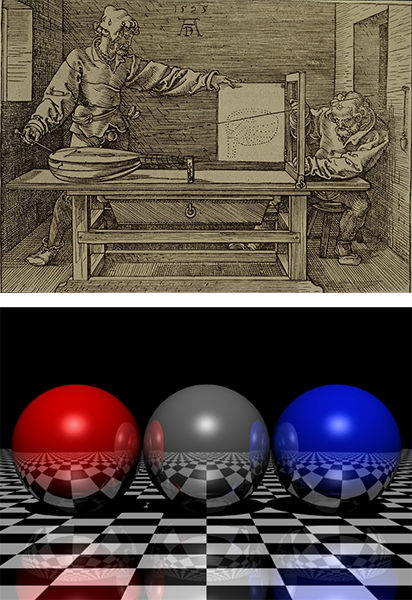
Figure 2.4. Both Man Drawing a Lute (1525) by Albrecht Dürer (top) and a typical example of ray tracing (bottom) represent mathematical models of light as vectors piercing a picture plane. Image by Patrick LeMieux, 2012 (bottom).
But what if the sun had begun to set on Butades’ daughter, transforming her lover’s silhouette into a monstrous grotesque? Or if Zeuxis had approached Parrhasius’ painted curtains from an oblique angle, disrupting the two-dimensional illusion of depth? What if Albrecht Dürer’s gridded glass “veil” had been bumped askew or if the algorithms responsible for rendering computer-generated imagery were not formulated properly? What if Aperture Science miscalculated the photographic effects of their Handheld Portal Device? Do subtle shifts in field of view or vantage point radically alter the human perception of perspectival images or is optical distortion actually a precondition for mimetic representation? Pliny’s myths of mimesis remain myths because they continue to express the desire for a technological correlate to human sight—a technology capable of rendering a painted, projected, or backlit screen into a transparent, immaterial, or immediate window.[12] The fantasy of immediacy stubbornly ignores both the material support of an image and the embodied response of a viewer, reinforcing the notion of a lossless transmission between an abstract set of Cartesian coordinates and an equally abstract Cartesian mind. Rather than buy into the fantasy of perspective (and those industries centered around perspectival technology and the exploitation of its myths), what if anamorphosis was recast as the rule governing vision rather than the exception to “normal” sight? What if there is no central, authoritative, or natural way of seeing despite the way optical technologies simulate the effects of light on the human eye? Even after the centuries-long construction of the modern viewing subject, the most naturalistic representational technologies still suppress a strange supplement. Whether examining early painting or traversing the polygonal environments of a virtual world, an anamorphic remainder looms in the interstices between technics, optics, and human perception.
The possibilities and problems of perspectival rendering have been inherited by the computer graphics industry, a field of research whose design goals and business models are deeply wedded to the progressivist logic of mimetic technologies. Despite the fact that there are only a finite number of unique polygons, pixels, and processes perceptible to the human eye, the videogame industry, for example, continues to invest in higher and higher visual fidelity. As graphics guru and co-founder of id Software John Carmack noted at the 2011 Electronic Entertainment Expo (E3), rendering technologies are “converging at the limits of our biological systems” (McCormick 2011). Having seen the so-called “limits” of 2D displays, in 2014 Carmack took a job as Chief Technology Officer at Oculus and, along with id Software’s Michael Abrash, is now exploring the affordances of VR headsets and the technical capacities of 3D gaming. With graphics technologies approaching the threshold of conscious perception, an increasing number of computer games are beginning to experiment with alternative spatial, temporal, and optical regimes indigenous to digital environments. Much like the restrained naturalism of Renaissance perspectival rendering led to a more self-conscious and reflexive Mannerist period of visual art, so have the nascent discourses surrounding computer-generated imagery and videogaming begun to internalize and amplify the codes of perspective to produce “anamorphic games.” From Portal to Fez and beyond, anamorphic games are games about games—mimetic metagames that dramatize the relationship between sight and simulation, vision and virtual reality to reimagine what it means to see by playing with perspective.
The Memento Mortem Mortis
Popularized during the Renaissance, anamorphosis is a rendering technique that results in a strangely stretched, but geometrically viable image. When attempting to “decode” the distortions applied to a given anamorphic artwork, onlookers must either assume an oblique viewing angle in relation to a foreshortened image or reflect a catoptrically warped image through a corresponding conic or cylindrical mirror. In 1927, Erwin Panofsky famously characterized traditional perspective as a “symbolic form” loaded with the Western ontology of the stable, fixed, and unified Cartesian subject (Panofsky 1996). Anamorphosis, on the other hand, is regarded as a marginal visual technique, a trompe l’œil that operates according to a different cultural logic, covertly applying pressure to the universality of classical perspective and all its ideological assumptions. But what if these assumptions were somehow reversed? Does not perspectival rendering, despite its cultural ubiquity and long history of perceptual conditioning, also require decoding? Is it even possible to see a perfect, perspectival image without minor distortions of eye, angle, and environment intervening? Though ease of rendering and conventions of human sight privilege this particular, historically contingent instance of mimesis, what if every perspectival image is actually anamorphic? What if anamorphosis was not only considered a means of encoding secrets in images, but was itself the secret that lies at the heart of all images?
Traditionally, perspectival rendering assumes that the position of the viewer is directly in front of and oriented toward the “picture plane,” a two-dimensional field that typically coincides with the material surface of an image. Conflating the picture plane with the angle and dimension of a canvas, for example, allows geometric projections representing light vectors to intersect with an unambiguous, material support (e.g., the surface of a canvas, the emulsion of a photographic plate, the phosphors of a screen, the photocells of a digital sensor, or even the pages of this book). This ideological conflation of mathematics and materiality removes the need for difficult, higher level modeling and simplifies the rendering process. The geometry of anamorphic images, however, requires nonstandard viewing angles by intentionally foreshortening the picture plane and decoupling it from the physical geometry of the painting, plate, panel, or page. This experimental and unconventional technique produces coded, mannered, and seemingly non-natural imagery. As such, anamorphosis is often regarded as a curiosity, an occasional virtuosic supplement to the catalog of classical perspective throughout the history of art. However, if the historical coincidence of the imaginary picture plane and the material surface of a painting is merely one particular case within a much larger field of possibility, then anamorphosis can be re-thought as the rule rather than the exception to perspectival image-making. In the same way that Richard Garfield observes “there is no game without a metagame,” no image exists without the anamorphic distortions produced by historical context, material composition, and bodily experience interacting with and influencing vision.
From the covers of book jackets to the commercials on television to the virtual cameras of first-person shooters, contemporary visual culture is dominated by perspectival modes of representation. It is easy to forget that mimetic images, no matter how naturalistic, require a cognitive leap in order to resolve the relationship between a mathematical system of rendering and embodied vision. By explicitly denying the so-called “correct” viewing position, anamorphosis forecloses the possibility of ever resolving the human gaze to the geometric parameters of an image. Anamorphic technique foregrounds the biological complexity of binocular vision, the angle of approach, height of a viewer, surface deformations of a medium, and even the atmosphere through which light passes. These anamorphic conditions undergird human perception and demonstrate that classical perspective—what has been culturally coded as “natural”—remains a highly constructed, mathematical method of simulating light rather than an accurate model of vision. Perspective is to vision what Newton’s classical mechanics are to quantum physics: a useful but ultimately inadequate approximation. Despite the popular desire for transparent, immediate experiences of media, conventional perspective is impossible to fully realize for viewer and painter alike. Whether standing in front of a canvas or grasping a controller, embodied vision is not properly perspectival but actually anamorphic, constantly modulated by embodied encounters with the material environment.

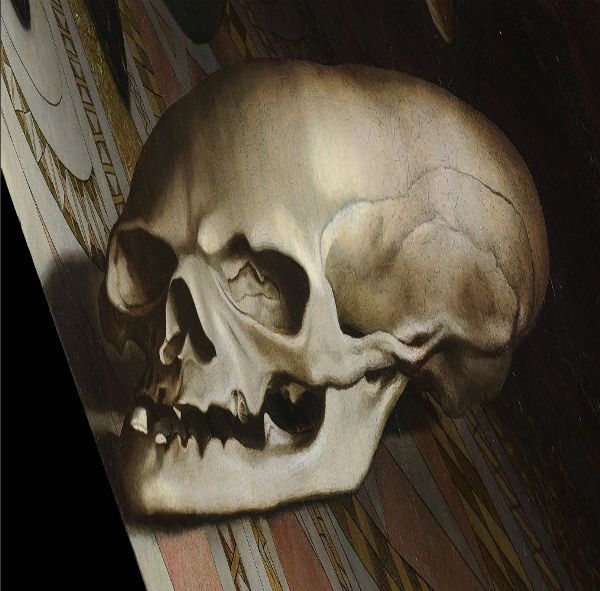
Figure 2.5. When viewed at an oblique angle, Hans Holbein’s The Ambassadors (left) reveals a strange, stretched skull (opposite page). Image by Thomas Shahan, 2011.
The quintessential example of anamorphosis is Hans Holbein’s The Ambassadors, a large and meticulously rendered oil painting featuring a strange, anamorphic “smear” across the bottom of the otherwise typical portrait of two sixteenth-century European diplomats (see Figure 2.5). In The Ambassadors, the two men stand costumed and well lit in a carefully proportioned, perspectival space, each with an elbow resting on the foreshortened table. The painting displays a menagerie of symbolic details denoting worldly opulence including fine clothing and foreign textiles, a lute with an open book of sheet music, two globes, and various instruments for navigation and cartography: technologies of rationalism that will help provide the “correct” perspective for mapping the New World. Yet, if the viewer examines the painting from an unorthodox position either above and to the right or below and to the left of the standard viewing angle,[13] the smear congeals into a grinning skull: a subliminal memento mori hidden in plain sight.
Although the inclusion of subtle reminders of mortality like skulls, timepieces, wilting flowers, or rotting fruit were common among portraits and still lifes produced in medieval and Renaissance Europe, Holbein’s memento mori is particularly unsettling given its uncanny manifestation through the technique of anamorphic foreshortening.[14] Here, the anamorphic skull is powerful not because it looks like a skull, but precisely because it does not look like a skull. Consider the possibility that this “not-skull” might reveal nothing to the viewer but paint. A sixteenth-century audience, for example, might have missed the skull entirely, only subliminally apprehending a death’s head upon one last, over-the-shoulder glance from the bottom of a stairwell or the threshold of an exit. Though it has the potential to trick the eye, this smear of abject materiality exists within its own ontological (and more specifically mathematical) register and casts an anamorphic doubt back into the previously perspectival world of the two diplomats. Working with the established cultural tradition of the memento mori, Holbein summons notions of death’s alterity as a metaphor for the ultimate strangeness of both the materiality of paint and the mathematics of perspective. This fleeting glimpse of a death’s head reminds the viewer not of their eventual expiration, but of the (perhaps more unsettling) fact that there exist objects and affects that exceed not only perspectival rendering but human experience altogether. The anamorphic skull renders a world of nonhuman technics that not only lies beyond the limitations of the human body, but is also completely disinterested in the affairs of man and the vagaries of life and death.
In this respect, it may be more accurate to use the term memento mortem mortis than memento mori.[15] The memento mortem mortis transforms the human-centered “remembrance of death” into the “remembrance of the death of death”—the realization that one day even death will die. Despite the impossibility of ever experiencing a world devoid of life, the memento mortem mortis invites the viewer to speculate on the radically attenuated phenomenology and starkly physical conditions of such a world. Where the memento mori mobilizes representations of death to challenge human vanity, the memento mortem mortis extends this critique beyond morbid anthropocentrisms by summoning not the representations of human death, but the nonhuman processes of technical objects. The result is not only the humbling acknowledgment of some thanatological equalizer between all human life, but also a call toward philosophical speculation. In this way, the painterly materiality of the anamorphic skull exposes a notion of cosmic indifference that is vaster, more alien, and more terrifying than the anthropocentric concerns of life and death represented through a memento mori. Throughout the history of painting, the skull, like other depictions of human detritus, has been used to signal human mortality. By stretching these skeletal remains across a separate, foreshortened picture plane that refuses to cohere with the geometry of the painted scene, the memento mori opens up the yawning abyss of the memento mortem mortis.
Anamorphosis, as well as those technologies that directly frame their nonhuman components in relation to human phenomenology, is just one example of a memento mortem mortis. In anamorphic images the subject and object never completely resolve for one another and there remains an incommensurable gap, as reflected in Holbein’s painting. In this sense, the human and the skull can never see eye to eye, and The Ambassadors functions as an allegory for de-anthropomorphized materiality in the idiom of early modern painting. Hubert Damisch (1995, 28) has argued that mathematical perspective was the dominant mode of image making in the twentieth century (far more than in previous eras prior to the development of mechanical forms of image inscription such as photography, film, and video). Yet these chemical, mechanical, electrical, and even computational forms of perspectival rendering can still each be regarded as cases of anamorphosis. All images are anamorphic insofar as they apply the rules of perspectival projection to an arbitrary and anthropocentric picture plane. The coincidence of the picture plane and material surface of the image is popular because of the convenience of calculating only one projection, rather than the multiple abstractions necessary for anamorphic rendering. Despite the fact that all paintings could be considered anamorphic under this definition, only some, like The Ambassadors, form a memento mortem mortis by explicitly questioning the necessary relation between the human body, an image’s material support, and the abstract geometries of the perspectival picture plane. Similarly, while the corridors of Black Mesa Research Facility can never entirely resolve to the player’s expectations, Aperture Science, Inc. builds anamorphic technologies explicitly designed to disrupt and disorganize perspectival space. For media theorists Espen Aarseth and Mark Hansen, the concept of anamorphosis functions more broadly as a paradigm for understanding digital technology in general, from stretched skulls to stretched skyboxes.
Ergodic Resolution and the Digital Any-Space-Whatever
At the end of Cybertext: Perspectives on Ergodic Literature (1997), Espen Aarseth embraces anamorphosis as a metaphor for what he calls “ergodic literature” and operates from the assumption that anamorphic images posit a privileged perspective from which to faithfully reconstruct an image. Taking examples from print, computer games, hypertext fiction, and electronic literature, in Cybertext ergodic literature is defined as those works whose completion requires “nontrivial effort” on the part of the reader (Aarseth 1997, 1–2). By nontrivial effort, Aarseth means the kinetic as well as intellectual labor performed by a reader or player that specifically influences the outcome or effect of a given text or game. Ergodic literature is distinct from most standard forms of writing because it requires meaningful effort above and beyond, for example, turning pages or flipping to the end of a book to read the final chapter. Considering Aarseth’s concept in relation to Holbein’s skull, a viewer’s self-conscious act of bending low to the ground in order to match the oblique angle of anamorphic distortion meets the requirements of ergodic labor. The active engagement required in any attempt to decode or decrypt anamorphic images is what leads Aarseth to make an analogy between early modern techniques of anamorphosis and certain forms of interactive media.
In the last chapter of his book, Aarseth (1997, 181) defines anamorphosis as a “solvable enigma.” For Aarseth, the defining quality of anamorphosis is the moment of revelation produced when the distortion of the warped image is resolved through the viewer’s effort to locate the vantage point from which classical perspective is restored. The passage from what Aarseth (1997, 91) terms “aporia” to “epiphany” connects anamorphic painting to ergodic literature (and videogames). With this in mind, Aarseth interprets the text-based games and interactive fiction of the late seventies and early eighties such as Will Crowther and Don Woods’ Colossal Cave Adventure (1975–76) and Infocom’s Zork trilogy (1980–84) as models of an anamorphic textuality in which the player must work in order for the mystery to be revealed. But not all ergodic texts provide puzzles with seemingly concrete answers, and Aarseth invents a second category he terms “metamorphosis” in which mastery and resolution are refused (e.g., Michael Joyce’s hypertext novel Afternoon: A Story [1987]).
There is no need, however, for a second category in which to reroute those texts that do not appear to have singular interpretations, linear causality, or solvable enigmas waiting at the ready. As suggested earlier, rather than reifying a specific subject position in front of a painting, image, artifact, or portal, the concept of anamorphosis radically critiques all subject positions as tenuous and fraught. Even if there is a viewing angle in which an image becomes more legible, there remains no one “correct” angle, and any resolution the viewer might feel should be met with some skepticism. The anamorphic skull in The Ambassadors is not a memento mori in the sense that it reminds the viewer of her mortality as she catches a glimpse of the skull through the corner of her eye, but is actually a memento mortem mortis because it calls into question the very concept of a fixed subject and resolved object. Rather than simply serving as a reminder of some distant future bereft of human life, the memento mortem mortis demonstrates that experience itself is already composed of nonhuman assemblages imbricated within a vast network of relations never entirely legible to conscious experience.
In contrast to Aarseth, in New Philosophy for New Media (2006) Mark Hansen deploys anamorphic artwork to parallel those aspects of digital media that explicitly fail to visually resolve and produce bodily discomfort because of the formal incongruity between embodied space and the speeds and scales of digital media. Specifically, Hansen’s close reading of skulls, an anamorphic sculpture by Robert Lazzarini in the tradition of The Ambassadors, challenges Aarseth’s concept of anamorphosis. For Hansen, skulls produces a “digital any-space-whatever,” a term he borrows from Deleuze to describe the uncomfortable, proprioceptive sensation produced in response to the disjunct ontological registers of digital media. It is precisely the failure of the human body to easily assimilate anamorphic images that Hansen finds useful for thinking about digital media. Robert Lazzarini’s sculptural installation skulls, exhibited at the Whitney Museum of American Art’s 2000 show BitStreams, serves as Hansen’s central case study on the issue (see Figure 2.6).
Recalling Holbein and Aperture Science, Inc., Lazzarini’s artwork engages the tension between systems of perspectival projection and the limits of human perception. Instead of projecting smears of paint across picture planes, Lazzarini builds smeared sculptures that stretch in three dimensions and challenge the viewer to reconcile vision and bodily proprioception. Where anamorphic images are rendered onto a foreshortened picture plane, Lazzarini’s sculptural process involves applying two-dimensional planar shifts (including perspectival effects) directly to the geometry of three-dimensional haptic objects.[16]
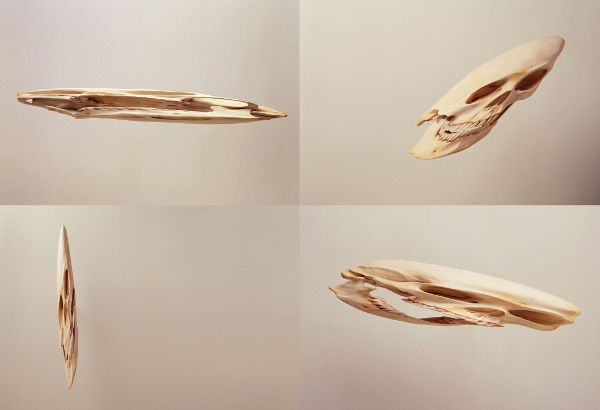
Figure 2.6. Robert Lazzarini’s skulls is an installation of four stretched and squashed sculptures that were laser scanned, mathematically manipulated, rapid prototyped, and then cast from bone. Photographs by Robert Lazzarini, 2009, reproduced with permission.
Lazzarini’s digital development process begins by laser scanning or solid modeling a common object, instrument, or weapon to generate an editable polygonal mesh. The geometric points, lines, and planes abstracted from each object are mathematically bent, warped, shifted, and distorted within modeling software before being 3D printed. The resulting rapid prototypes are not finished products, but serve as templates for physically sculpting the now-deformed models from the same materials that constituted the original object (e.g., the stretched skulls are cast in bone). Although this complex process remains relatively consistent throughout his catalog, Lazzarini’s diverse array of subjects are selected to enhance the cognitive dissonance created between the materiality of his anamorphic sculptures and their perceptual effects. Ranging from skulls to violins, hammers, teacups, telephones, telephone booths, chairs, knives, revolvers, and brass knuckles—although, unfortunately, no crowbars yet—these objects and weapons share one thing in common aside from their anamorphic effects: an ergonomic reference to the human body. It is only through this remarkable conflict between optic and haptic sensations that Lazzarini’s sculptures become tools from another digital dimension: hammers with ungraspable handles.[17]
Among this selection of digitally disfigured tools, skulls stands apart. These sculptures do not share the same status as the broken, Heideggerian hammer that reveals its nonhuman character only once it ceases to function for a human operator’s intended use. Like The Ambassadors before it, Lazzarini’s stretched skulls are not broken at all. Instead, the anamorphic objects operate as intended. They produce a memento mortem mortis that frames nonhuman fields of experience within the register of human utility. The horizon of unthinkability represented in skulls serves as a means to philosophical inquiry. Here the very idea of unthinkability enacted in these uncanny objects becomes a kind of technology—a useful (and fully operational) philosophical tool for speculation. The optical instability of Lazzarini’s sculptures draws attention to this speculative horizon as a means of re-inscribing it within the sphere of human perception. There is a certain irony to the fact that skulls maintains a kind of functionality despite its anamorphic tilts, shifts, twists, and turns. The fact that viewers cannot fix their gaze on a stable optical regime only intensifies the skulls’ role as a memento mortem mortis. Technically, skulls does what it is supposed to do—it enables philosophical, aesthetic, and contemplative work.
Despite their physical status and oblique reference to the history of the memento mori in painting, in a chapter titled “The Affective Topology of New Media,” Hansen (2006b, 202) argues that Lazzarini’s sculptures are “exemplary of digital media art.” Lazzarini’s sculptures exist physically within three-dimensional space and yet, no matter what angle the distorted objects are viewed from, they fail to visually resolve in a satisfying way. Looming in life-scale and cast in bone, the digitally modeled skulls renders one of the most visually recognizable parts of human anatomy strange and uncanny. Their hollow eyes refuse to stare back. If an observer closed her eyes and held Lazzarini’s stretched skulls, the contours would resolve to the haptic touch, but as Hansen (2006b, 202) writes, skulls “‘makes sense’ visually—only within the weird logic and topology of the computer.” Because of their technical status as digital media art, skulls becomes a means through which Hansen describes the incommensurable ontology of a computer. Lazzarini offers an optical distortion designed to disrupt, rather than pacify, the senses. The sculptures produce a bodily experience that Hansen labels the “digital any-space-whatever”[18] (digital ASW), a proprioceptive sense akin to nausea or vertigo as the body fails to orient itself—a category of play that Roger Caillois (2001, 12) calls “ilinx.” Hansen (2006b, 198–99) writes that in the face of skulls “you feel the space around you begin to ripple, to bubble, to infold . . . and you notice an odd tensing in your gut, as if your viscera were itself trying to adjust to this warped space.”
Hansen (2006b, 205) concludes his analysis with the suggestion that “what skulls affords is, consequently, not a direct apprehension of an alien space that is digital, but a bodily apprehension of just how radically alien the formal field of the computer is” (emphasis original). In this sense the memento mortem mortis and the digital ASW go hand in hand—reminders of an expanded, nonhuman terrain driven by a necessarily incomplete (or anamorphic) apprehension of the speeds and scales of technical media. In an artwork like skulls, which is as psychologically unsettling as it is proprioceptively disruptive, experiential strangeness quickly transforms into existential thinking when confronted not with mortal remains, but with the irresolvable and indigestible remainder of the memento mortem mortis. Though Hansen’s concept begins as an embodied, affective sensation, the digital ASW gestates within the same inclement ontological spaces conceptualized by the memento mortem mortis.
Videogames, like all digital media, are built upon mechanical, electrical, and computational process that inform, yet operate outside human experience. The nonhuman speed of switches being flipped, the mind-numbing repetition of serial data being sequenced, the irreducible materiality of magnetic platters being polarized, and even the mechanics of interdimensional portals being opened and closed at Aperture Science can never be fully represented to human sensibility. Instead, the memento mortem mortis emerges from the incongruity between computational and human forms of space and time that manifests as an embodied and affective response (i.e., Hansen’s digital ASW) to allegorize these invisible processes. Whereas a work like skulls emphasizes the failure of the viewer to grasp these forever skewed and uncanny objects, most videogames do not generally make a practice of cultivating sensory discomfort. But what if a body were required to negotiate two- and three-dimensional spaces simultaneously, as with Sony’s Echochrome software? Can muscles remember the extra-dimensional abstractions of Julian Oliver’s levelHead? And is it possible to see four-dimensional geometries as Mark ten Bosch’s Miegakure claims?[19]
From Portal to Echochrome to levelHead to Miegakure, the anamorphic games examined in the remainder of this chapter intentionally play within the dissonant registers produced between biological and computational systems. They produce ludic metaphors of the memento mortem mortis to model an engagement with an unthinkable computational space. Yet, despite their experimentation with alternative haptic and visual regimes, even these metagames about games resist pushing the implications of anamorphosis to its limits. Rather than forcing the player to stare an inassimilable digital landscape in the face, they persist in offering a fantasy of mastery through the successful completion of goal-oriented tasks and suggest that the body can be acclimated to their eccentric spaces. Flight simulators may be developed to combat airsickness, and it is with a similar logic that these anamorphic games invite players to test-drive the digital ASW, to make it safe and naturalize the body to the “incredible strangeness,” “odd tensing[s],” and “weird sensation[s]” of the memento mortem mortis (Hansen 2006b, 198–99).[20] As GLaDOS quips in her game’s trailer “now you’re thinking with portals” (Valve 2006).
Echochrome: Anamorphic Architecture and Shadow Play
When the first generation of home videogame consoles supporting 3D graphics processing was introduced in the mid-1990s, the development of 2D, sprite-based games was temporarily arrested.[21] In the flush of fascination with these strange polygonal spaces, the efforts of software engineers and game designers alike were redirected from sprite sheets, parallax scrolling, and painting with pixels—or “dotting”—to domesticating and naturalizing 3D environments for mainstream consumption. Since the indie boom of the late 2000s, however, there has been a renaissance of 2D platforming games that explicitly reference the technological constraints, pixelated aesthetic, and ludic genres of 8-bit games like Super Mario Bros. (1985), The Legend of Zelda (1986), and Tetris (1989). The flatness of the screen and depiction of 2D space are no longer technical limitations but creative constraints—design choices that can be placed in conjunction with 3D spaces to create metagames about graphics processing and computer rendering itself. From Super Paper Mario (2007) to Portal, anamorphic games are not only metagames about graphic technologies, but about aboutness itself.[22] One series of games that structures its gameplay around the perspectival play of both two- and three-dimensional spaces is the “Echo” franchise, which includes Echochrome (2008), Echoshift (2009), and Echochrome II (2010).
Produced by Sony’s Japan Studio and Game Yarouze for the PlayStation Portable (PSP) and PlayStation 3 (PS3), in Echochrome the player is presented with a minimal, white space featuring a centralized, floating object composed of stairs, walkways, ramps, and ramparts reminiscent of M. C. Escher’s illustrations of impossible spaces and paradoxical architectures (see Figure 2.7). When the joystick is tilted, Echochrome’s hovering levels rotate and, unlike a hand-drawn optical illusion, reconstitute their perspectival conditions in real time. All the while, a solitary figure strolls back and forth, footsteps clacking in empty space. The lone resident of these “endless walkways” (the rough translation of Echochrome’s Japanese title, Mugen Kairō) is a white, textureless mannequin who autonomously wanders up and down the crisply contoured, isometric expanses. Both the oblique reference to Escher’s artwork and the mannequin (a tool traditionally used to help model perspectival figures) are fitting considering that the game’s primary mechanic involves rotating anamorphic architectures in ways that paradoxically play with the dichotomy between screen and space.
In Echochrome, there are five main rules governing the mannequin’s movements:
- 1. When two separate pathways appear to be touching, they are.
- 2. If one pathway appears to be above another, it is.
- 3. When the gap between two pathways is blocked from view and the pathways appear to be connected, they are.
- 4. When a hole is blocked from view, it does not exist.
- 5. When the mannequin jumps, it will land on whatever appears beneath it. (Sony 2008)
These five laws of perspective define the relationship between two- and three-dimensional spaces within the world of Echochrome. By inverting the order of perspectival rendering, the pictorial logic of the screen is given precedence over the mimetic representation of space. What you see is literally what you get.
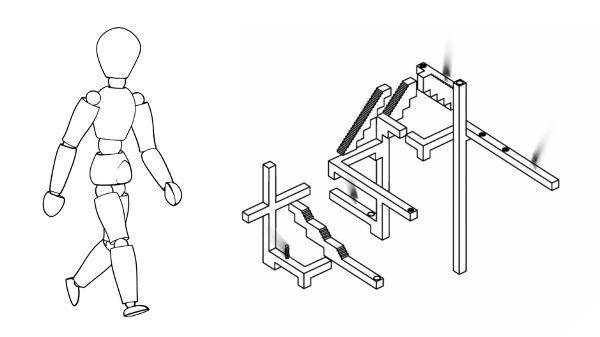
Figure 2.7. Echochrome’s mannequin main character and illusionistic level design reference both the traditions of perspectival naturalism and the anamorphic effects of M. C. Escher’s artwork. Sony advertisements, 2008.
Echochrome recalls The Ambassadors in the way it mixes traditional perspective with anamorphic effects. By placing both two- and three-dimensional space in conversation with each other, the game conflates the dual logic of flat “screen” and deep “window,” two metaphors Anne Friedberg contrasts in The Virtual Window: From Alberti to Microsoft (2006). In her book, Friedberg argues that although perspective has been the historically dominant form of visuality, computer-generated imaging has dramatically transformed how space is culturally perceived and organized. She examines the graphic user interface of computer desktops and the way they are composed of multiple, overlapping windows, conflicting light sources, and purely abstract drop shadows. Although Leon Battista Alberti famously described classical perspective as a “window” onto another world, Friedberg critiques Alberti’s metaphor[23] and demonstrates how computer software companies have appropriated similar rhetoric for describing the non-perspectival, nonlinear incongruities and contradictions of computer operating systems. In this sense, the flattened desktop and overlapping panes of Microsoft Windows has become a “window”—the artificial tropes and interface metaphors of operating systems have become naturalized as yet another form of realism.[24]
Echochrome stands out as a particularly intriguing example of alternative spatial organization because it knowingly plays with the tension between pictorial and sculptural space. As the player rotates the central object in three dimensions, real-time graphics processes render an illusion of depth, with the screen or monitor serving as virtual window. Near and far, broad and deep, Echochrome’s rotating spaces appear to behave rationally. But when the motion stops, the collisions and connections of the Escher-esque architecture are ultimately determined according to the logic of the suspended two-dimensional image. The “window” into another realm flattens into an opaque screen.[25]
Adjusting Echochrome’s perspective transforms not only the player’s view, but the composition of the architecture itself. The spatial dimensions and composition of the object are not fixed in space. Instead, the in-game architecture is reconstituted depending on the angle from which it is viewed. In the tradition of Espen Aarseth’s concept of ergodic literature, this is perspectival rendering structured within the logic of ludic mastery, and it operates according to fixed points of resolution—more a puzzle game than a puzzling game. If the player rotates the architecture correctly, or, more precisely, manipulates the in-game camera to the proper coordinate, the puzzle will be solved and the secret revealed. Discovering the solution to these levels and cracking their spatial codes, promotes a reductive model of anamorphosis—one that equates embodied vision with an absolute, mathematical result produced by a virtual camera. In this sense, Echochrome differs from a work like skulls in which there is no chance of ever decoding the sculptural smears into perspectival representations. The game’s ludic logic acts as an interface through which the player finds herself able to assume a naive position of control and mastery of those perspectives that would otherwise be hopelessly irresolvable. According to Echochrome’s eccentric camera, the human eye is reduced to a one-dimensional point in space, perfect for projecting and reflecting ray-traced light.
Whereas Echochrome creates a world built around the intersections of two- and three-dimensional space, its sequel, Echochrome II, adds the play of light and shadow to its predecessor’s uniquely hybrid perspective of multi-dimensional objects. Once again, what you see is what you get. The mannequin’s silhouette, referred to as “the cast,” must traverse visual puzzles through the player’s anamorphic manipulations of light. In Echochrome II, the cast does not walk along the physical objects, but is literally cast along the shadowy, two-dimensional projections that fall in the wake of floating blocks, stairs, and steps (see Figure 2.8).
Similar to its predecessor, Echochrome II was developed by Sony’s Japan Studio and made for PS3 but, unlike Echochrome, the sequel requires the PlayStation Move, a motion-sensing hand controller spatially tracked by the PS Eye, Sony’s interactive, infrared camera.[26] The Move controller is topped by a glowing sphere that flickers and changes colors when the wand is active, emitting infrared light for the PS Eye to behold.[27] This motion-tracking technology inverts the relationship between controller and camera popularized by the Nintendo Wii, which emits two infrared points of light from a stationary bar set near the screen and tracked by a camera within the Wii Remote (aka the Wiimote) (see Figure 2.9). In Echochrome II, this light-tracking technology is used to position an in-game light source which, when cast on the floating objects, produces virtual shadows in real time based on the player’s bodily gestures. These motions translate into the screen’s perspectival space as the player shines the Move controller on their television like a virtual flashlight. Rays are traced from the tip of the wand at the precise angle of incidence and projected from an in-game light source behind the camera in order to “pierce” the screen and produce the appearance of an out-of-game light source illuminating in-game objects and architectures.
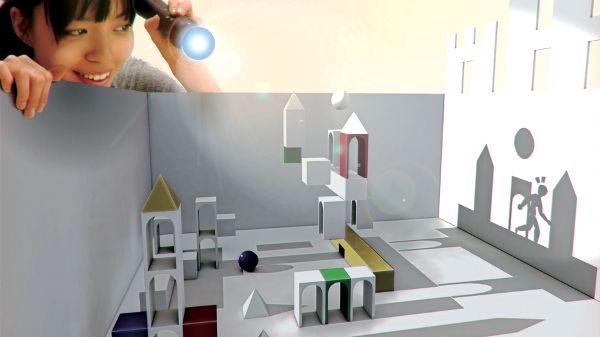
Figure 2.8. An Echochrome II advertisement features interactive illumination and promises an experience so immediate that the screen between player and game vanishes.

Figure 2.9. A comparison of Sony’s PlayStation Move and Nintendo’s Wii Remote reveal similar design sensibilities.
The shadows produced by the Move evoke the flickering lamp flame from Pliny’s account of Butades’ daughter. But rather than assume a visual symmetry between silhouette and object (the way in which this myth has been traditionally depicted in various paintings), the game reveals the dissonance and distortions that prevail in the world of shadows.[28] In Echochrome II, the player can adjust the light source in order to produce anamorphic shadow play. If a player positions the controller at a particular angle, in the same way a viewer might position her body in relation to The Ambassadors, the game will reveal hidden, albeit banal, images (e.g., a robot, a smiling face, a snake, etc.), simultaneously converting previously insurmountable obstacles into more conventional 2D platforms for the player-controlled “cast” to hop, skip, and jump across (see Figure 2.10). Just as Butades used the shadow traced by his daughter to cast a relief portrait, Echochome II conflates silhouette and sculpture to model not earthen effigies but polygonal pathways. These digital projections not only operate according to the pictorial logic of two-dimensional shadow play, but are assigned an autonomous physics and materiality distinct from the original objects. The glowing orb simulates a cycloptic eyeball, projecting unique perspectives as the player learns how to alter the angle of the light source in order to play with distorted, anamorphic images.
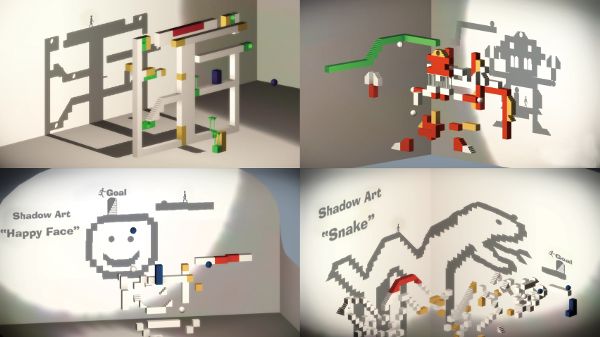
Figure 2.10. In Echochrome II, positioning the Move controller in relation to the screen reveals anamorphic images within the shadows.
Both Echochrome and Echochrome II produce spatial effects that are unique to the logic of the computer, but they depart from the memento mortem mortis by generating puzzles as “solvable enigmas.” Both games encourage the player to participate in a fantasy of mastery by simulating anamorphic effects within a deterministic gamespace. Whereas anamorphic painting requires a player’s body to physically adjust in relation to the object, these videogames produce anamorphic encounters through in-game camera rotation. Echochrome doesn’t actually require a bodily perception of space, but uses perspectival rendering in a way that mimics anamorphosis. Similarly, Echochrome 2 simulates a perspectival “eye” as a single point in space through using Sony’s Move. In this sense, players only see the shadow play of Echochrome 2 secondhand. Rather than activating perspective through vision, they render the gaze of a camera eye, adjusting the Move controller in order to project perspectival imagery onto the screen. Though the Echochrome games require haptic input, the mathematical transformations depicted in each polygonal space do not enliven an expanded, anamorphic field of affective, bodily experience but instead work to reinforce the hegemony of vision. Anamorphic distortions in the Echo series are framed in such a way that a properly perspectival solution is always the correct answer, repressing any sense of a radical encounter with the memento mortem mortis. Despite the play between two- and three-dimensional space, these metagames about perspectival rendering and user-friendly interfaces function merely as shadow boxes that ludically reinforce a naive fantasy of mastery by adhering, slavishly, to one-dimensional puzzles with one-dimensional solutions.
levelHead: A Multi-Dimensional Memory Palace
Echochrome II is designed to function with (and market) a specific commercial remote: Sony’s PlayStation Move. In 2010 a generation of controllers, inspired by the success of Nintendo’s unconventional Wii Remote, challenged the joystick-button and mouse-keyboard input combinations that have served as the industry standard in terms of interface design. Hardware like Nintendo’s Wiimote, Sony’s Move, and Microsoft’s Kinect expand players’ attention beyond their two thumbs by incorporating motion tracking and gesture recognition. Despite explicitly reframing input in terms of the body, these technologies fall under the category of “natural user interfaces,” or NUIs, that ideologically reinforce the longstanding desire for a seamless and immersive form of interactivity in which the body is rendered invisible and vision is indexed precisely to the algorithmic abstractions on the screen. Amidst this turn toward so-called NUIs, media artist Julian Oliver designed a piece of software and a unique control scheme that does not take embodied forms of interaction for granted.
In 2007, Oliver created levelHead, an interactive installation exhibited in museums and galleries (as well as on the home computers of tenacious Linux users) (see Figure 2.11). The game combines color-coded and patterned cubes with custom, open-source software and a webcam to motion track and replace the six unique quick response (QR) codes of each cube with three-dimensional, interactive architecture. The result is a large, real-time video projection that displays the player’s hands interfacing with the virtualized cubes—each facet filled with internal geometries. The cubes serve as both screens and joysticks, and, as with Echochrome and Echochrome II, the player’s physical gestures and positioning change the perspectival viewport to propel a small, white, humanoid silhouette who anonymously strolls through a six-sided interior space. This unassuming avatar, like the minimally designed “cast” featured in the Echochrome series, follows the path of least resistance based on the angle at which the player holds each QR-encrusted cube. By tilting the cube-controllers, the player indirectly steers this avatar that simply walks forward, a lost soul wandering aimlessly through shifting architecture. The three cubes work in sequence, each containing six unique rooms overlaid within the same physical space for a total of eighteen “levels.” By tracking objects and actions instead of interfacing with standardized controller input and by projecting the results back on that which is being sampled, Oliver’s augmented reality game extends the perspectival space of the screen to the physical environment and vice versa.
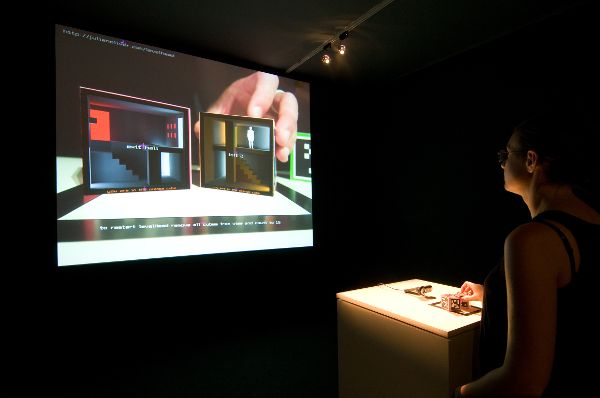
Figure 2.11. The installation of levelHead with cube-controllers, camera, and projection results in an augmented reality game at Ars Electronica 2008 in which manual manipulations are mapped to a virtual memory palace. Photograph by Otto Saxinger, 2008.
The inside of each of levelHead’s cubes is articulated as if it were a shadow box, but when the player presents a new QR-encoded face to the camera, an entirely different space appears. The difficulty of levelHead, then, is to imagine six simultaneous rooms within the geometry of the single box in hand. This challenge, as Oliver has written, is complicated when one must remember the spatial organization of six discrete geometries despite the fact that they are not simultaneously present or interconnected in a way that is physically possible. The logic of the cube’s architecture, therefore, must be constructed out of a different set of haptic cues, engaging with the wrist and hand rather than the screen and eye. As Oliver (2009) details on his website,
the tangible interface aspect becomes integral to the function of recall. . . . As the cube is turned by the hands in search of correctly adjoining rooms muscle-memory is engaged and, as such, aids the memory as a felt memory of patterns of turns: “that room is two turns to the left when this room is upside down.”
Although Oliver (2009) offers a walkthrough on YouTube, he notes that the game is “very difficult” and, given the two-minute time limit to finish each puzzle, it is doubtful many have fully toured what he calls “the apartment.” Thus, for the vast majority of players, engagement with levelHead comes closer to producing an experience of Hansen’s digital ASW and the existential doubt of the memento mortem mortis than Echochrome’s “solvable enigmas.” The cube-controller each player holds inevitably transforms into a kind of virtual skull, a reminder of an anamorphic discrepancy between eye–hand coordination and camera–computer calculation.
When grasping the “level heads,” hands and wrists immediately organize each cube into a coherent program that does not necessarily comply with the images on the screen. As Oliver points out, the body grounds the player’s frame of reference even as she grapples with architecture removed from standard forms of spatial orientation. There is a palpable disconnect between what the player feels when holding each solid cube and what she sees projected on the screen. The incommensurability between haptic and optical feedback in levelHead recalls the phenomenological problem articulated in Lazzarini’s skulls. Were a viewer to close her eyes and place her hands on the stretched sculptures, the digital-born objects would resolve to the touch. Yet, without haptic feedback, the visual distortions throw off the viewer’s equilibrium to produce the feeling of a digital ASW. Oliver’s levelHead makes a game out of negotiating haptic orientation with a visual and cognitive disorientation and dramatizes what Andy Clark and David J. Chalmers (1998, 8) characterize as “the externalization of thought”—a phenomenon in which level and head can no longer be separated.
In their short essay, “The Extended Mind,” Clark and Chalmers cite a 1994 study by David Kirsh and Paul Maglio in which participants were asked to play the game Tetris (1985). In Kirsh and Maglio’s (1994, 518) experiment, data was collected in three ways: (1) the unobtrusive sampling of real-time keystroke data as advanced, intermediate, and novice gamers played Tetris; (2) tachistoscopic tests of the same subjects performing cognitive rotation tasks related to Tetris; and (3) an “expert system” called Robotetris built as a machine control for the experiment. After comparing the results of these three groups, Kirsh and Maglio discovered that when enabled by environmental as well as bodily support, human players are far more efficient when playing Tetris. Using a controller, participants performed the operation in 300 milliseconds (200 milliseconds to press a button, then 100 milliseconds for the screen to refresh), whereas it took around 1000 milliseconds for the same result to be achieved mentally (measured with standard tachistoscopic tests). For Clark and Chalmers, this study empirically demonstrates how cognition exceeds not only the mind, but the hand as well—consciousness codeveloping in concert with environment and body to produce a different kind of levelHead.
While Kirsh and Maglio explain how prosthetic technology transforms cognition using the example of Tetris, few videogames explicitly attempt to trouble this relationship. Conversely, the ability to recall space in levelHead overtly depends on both the body and a series of external apparatuses due to the fact that the architecture produced in the game cannot be visualized accurately in three-dimensional space. As Oliver emphasizes in an artist statement, the muscle memory of the hand is indispensable for successful navigation of the game’s paradoxes. Although seasoned players of almost any videogame are acutely aware of the operation of muscle memory, many games foreground the autonomy of vision (through, for example, the presence of cutscenes) and the primacy of visual memory and mental modeling (in the case of most puzzle games). By contrast, levelHead does not take hand, body, or cube-controller for granted or treat them as merely instruments for executing orders. Oliver’s game is built around the conceit that all the interactions within a cybernetic system are a necessary precondition for comprehending and traversing the environment.
The Tetris study further erodes the Cartesian model of mind–body dualism, demonstrating a distributed form of cognition that puts pressure on the question of where the body stops and the rest of the world begins. Ironically, this example of situated cognition is constructed around a cognitive aporia. The incommensurable gulf between the processes of a computer and the embodied engagement of the human is also necessary for the system to function: the dash in human–computer interaction signifies this chasm. Thus, Oliver’s “level heads” tilt, shift, twist, and turn into versions of the smeared skull, challenging the player to peer into an irresolvable and paradoxical architecture. Clutching this existential object, a memento mortem mortis, the player glimpses into a space beyond human thought, beyond the debates of “to be or not to be,” into a dimension where these questions are rendered insignificant.
Beyond the simulated cameras and onscreen architecture of Echochrome, levelHead extends anamorphic distortion to the embodied space of the human viewer. By creating a mathematical projection in which six interconnected rooms coexist within the same three-dimensional space, levelHead inverts the standard notion of projection and plays with a kind of fourth-dimensional logic. According to the space depicted of the screen, these six three-dimensional rooms exist within the same cube, overlapping each other. Although only one room is visible, the player can imagine the cube functioning like a tesseract or hypercube. The player must imagine six three-dimensional cubes contained within the cube she holds in her hand, although only one set of three-dimensional coordinates is observable at any time. This conceptual abstraction stands in for the player’s encounter with the alien and inaccessible ontology of the everyday technological objects with which we surround ourselves. Anamorphosis becomes a means to aestheticize this encounter with what Ian Bogost has called the “alien phenomenology” of the computer.
Miegakure: A Garden of Many Forking Dimensions
While levelHead’s disorienting architecture implies a fourth-dimensional space and marshals the memento mortem mortis to allegorize this potential, Marc ten Bosch’s forthcoming Miegakure: A Garden in Four Dimensions directly incorporates four-dimensional mathematics into its game design philosophy. Both Echochrome and levelHead experiment with perspectival systems in which the laws of two- and three-dimensional perspective overlap with each other. Miegakure, on the other hand, adds one more spatial register in order to attempt to create a four-dimensional puzzle platformer (see Figure 2.12). Although visualizing the fourth dimension stretches the very limits of imagination, it is relatively simple to represent mathematically. This is a space where the abstractions of math and physics discourse freely and the body may be able to affectively register interdimensional shifts at a subconscious level, but perspectival vision is more or less left in the dark. For this reason, the fourth dimension has been a curiosity for artists wishing to critique the ocularcentrism of classical perspective and Cartesian space.
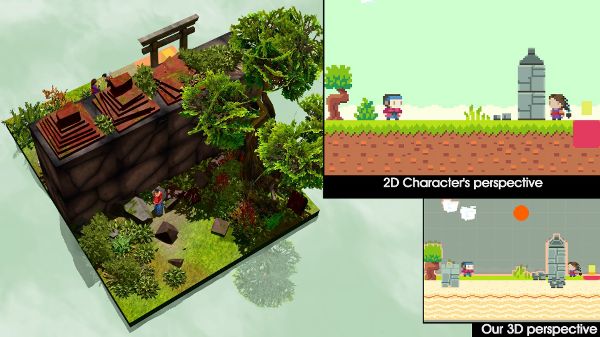
Figure 2.12. The tutorial sequence in Mark ten Bosch’s forthcoming Miegakure introduces players to a Japanese “garden of forking paths” that operates according to not three, but four spatial dimensions.
In her work on fourth-dimensional theories of twentieth-century art, Linda Dalrymple Henderson (1984, 205) writes that “the fourth dimension was a concern common to artists in nearly every major modern movement” because it “encouraged artists to depart from visual reality and to reject completely the one-point perspective system that for centuries had portrayed the world as three-dimensional.” Though many visual artists throughout the twentieth century dabbled in four-dimensional theory—from multi-point and non-perspectival Cubist renderings to Surrealist explorations of scientific theories like the non-Euclidean spatial geometries of Henri Poincaré—ten Bosch takes his inspiration from Edwin Abbot’s Flatland: A Romance of Many Dimensions (1884), a nineteenth-century novel narrating a square’s journey through one-, two-, three-, and eventually four-dimensional space.
Faced with the paradox of representing the unrepresentable, ten Bosch’s strategy is to create a gamespace in which each three-dimensional coordinate contains not three, but four points of information. As written on ten Bosch’s (2011) website, “at the press of a button one of the dimensions is exchanged with the fourth dimension, allowing for four-dimensional movement.” Thus, a block situated within a three-dimensional grid will appear to magically “smear” across the screen by substituting a given coordinate for a hidden fourth point in another space. Mathematically, one can make n-dimensional objects by simply adding more and more coordinates alongside the traditional designations for width, height, and depth. What exists as a computational abstraction cannot be completely articulated on the two-dimensional screen, but the process of substituting alternate sets of data simulates the traversal among four spatial dimensions.[29]
Ten Bosch does not treat this relationship between gameplay and fourth-dimensional physics merely as a form of symbolic substitution. He proposes that Miegakure grants access to the fourth dimension, allowing players to “experience it first-hand, using trial and error, as opposed to being told about it” and promotes a fantasy of mastery, colonization, and control over four-dimensional space (ten Bosch 2011). Despite his ambitious claims, the deeper significance that will ultimately be gained from Miegakure is not “first-hand” knowledge of the fourth dimension, but knowledge of the computational processes of the videogame itself. It is in this respect that Miegakure’s fantasy of traversing the fourth dimension becomes a metaphor for traversing the mathematical abstractions made possible by the microtemporal process and macroscalar storage of digital media. The gameplay of Miegakure recalls Hansen’s (2006, 202) claim about the way in which the anamorphic space of skulls stands in for the “weird logic and topology of the computer.”
In Gaming: Essays on Algorithmic Culture, Alexander Galloway (2006, 106) argues that videogames are “allegories of control”; they are cultural objects which rhetorically present themselves as sources of interactivity and agency, yet in doing so conceal the “protocological network of continuous informatic control” under which we now live. Videogames ultimately relegate player behavior to a strict system of rules that allegorize contemporary informatic culture at large. One might further add that videogames function not only as allegories of control, but as allegories of the beyond. By presenting a set of computational processes as rules for organizing play, videogames invite players to discover the constraints and affordances of a given gamespace and along the way remind oneself of the limits of the human body. To play a game is to test a nonhuman system, to uncover (and be uncovered by) the codes that will produce both experiential dissonances like the digital ASW while opening fields for philosophical speculations. In Miegakure, the fourth-dimensional exercises depicted in the game’s diegesis and its computational dynamics are interlinked. Miegakure establishes a homology between the fourth spatial dimension and the internal workings of a computer by placing them within the same experiential register: at the limits of human perception. By attempting to colonize computational space through the insertion of a human agency, Miegakure adopts the ambitious premise that the formal topology of computational space can be manipulated, controlled, and conquered absolutely (when, as Galloway [2006, 106] observes, videogames in fact excel at accomplishing the opposite). Ten Bosch’s game delights in the telic fantasy of extending the human agency into spaces and places where it does not belong.
The gap between what is possible to represent in mathematics and what is sensible within human phenomenology is the inspiration for Quentin Meillassoux’s (2008, 7) concept of “the great outdoors” in After Finitude. Rather than thinking of the great outdoors in the tradition of Caspar David Friedrich and those works of sublime art that situate the human subject among the overwhelming sublimity of nature, Meillassoux (2008, 26) uses the expression to refer to a universe that persists beyond the horizon of human correlation, writing, “This is the enigma which we must confront: mathematics’ ability to discourse about the great outdoors; to discourse about a past where both humanity and life are absent.” The term miegakure, ten Bosch (2011) clarifies, is Japanese for “hide and reveal” and refers to a specific gardening technique used in Japan. The game is set within a Japanese Zen garden, evoking a space of contemplation and relaxation as the player ponders mathematical abstractions and interdimensional ontologies. Like Mark Z. Danielewski’s House of Leaves (2000), Miegakure’s four-dimensional gardening techniques conjure a space that is paradoxically larger on the inside than the outside. The objects in the garden interweave with one another and expand through multiple dimensions. The gardening metaphor is particularly apt because a garden not only represents a space of contemplation, but one of control and the domestication of nature. Ten Bosch’s game can be read as an attempt to domesticate a computational wilderness, to seize the great outdoors, and till the land such that it falls back under the purview of human experience and agency. By creating a homology between anamorphic techniques and the great outdoors, Miegakure pushes anamorphic games into the next speculative dimension by procedurally rendering an allegory of the beyond.
Games of Speculation
The fascination with a computational wilderness, the great outdoors of digital space, is at play in Ian Bogost’s New Mexican landscape, described at the beginning of Alien Phenomenology (and at the beginning of this chapter). Synthesizing the recent proliferation of philosophies that fall under the umbrella of Speculative Realism, and specifically engaging with Graham Harman’s version of Object-Oriented Ontology, Bogost embraces the alien nature of quotidian objects, from microwavable casseroles to steel corridors and crowbars. Bogost (2012, 9) describes how the material world of things has been de-privileged in the face of the sturm und drang of human drama, arguing,
If we take seriously [Graham Harman’s] idea that all objects recede interminably into themselves, then human perception becomes just one among many ways that objects might relate. To put things at the center of a new metaphysics also requires us to admit that they do not exist just for us.
These concealed and re-distributed relations underwrite Bogost’s construction of an alien phenomenology. Bogost (2012, 34) declares that “the true alien recedes interminably. It is not hidden in the darkness of the outer cosmos nor in the deep sea shelf, but in plain sight, everywhere, in everything.” What would you do if the alien were everywhere? The answer, for Bogost, is wonder. “Despite all the science fictional claims to the contrary,” he writes, “the alien is different. One does not ask the alien, ‘Do you come in peace?’ but rather, ‘What am I to you?’ The posture one takes before the alien is that of curiosity, of wonder” (2012, 133). In Alien Phenomenology, Bogost attempts to reinscribe a sense of respect for the mysteries of quotidian objects—for the alien that does not arrive from a galaxy far, far away but is part of our everyday lives. “It’s everywhere,” he asserts, and perhaps this is most deeply felt when one is attending to what peers back from the remote space of the smart phone, the laptop, the ATM machine, or other quotidian computers (Bogost 2012, 133).
Bogost’s response to this call of the wild is to practice wonder, but this is by no means the only answer philosophers have posited. On the other hand, is not horror the obverse of wonder? Horror comes closer to the feeling Hansen describes as the digital ASW and what Eugene Thacker articulates in his book After Life (2010). In After Life, Thacker explores the philosophical concept of life and living. Also informed by the recent explosion of speculative philosophies which redirect philosophical inquiry away from the human toward “a politics of life in terms of the nonhuman or the unhuman,” Thacker (2010, 5) turns to the fantasy writing of H. P. Lovecraft to find creative models for thinking that which exists beyond thought. Lovecraft, he argues, “presents the possibility of a logic of life, though an inaccessible logic, one that is absolutely inaccessible to the human, the natural, the earthly, an ‘entelechy of the weird’” (Thacker 2010, 23). What Thacker identifies as “weird” in Lovecraft’s writing, is the same speculation at work in the anamorphic gameplay of videogames that work to test or allegorize the limits of human experience. While Lovecraft attempts to name the unnamable, these games convey the sense of playing the unplayable. As Thacker (2010, 23) writes, “the weird is the discovery of an unhuman limit to thought, that is nevertheless foundational for thought. The life that is weird is the life according to the logic of an inaccessible rift, a life ‘out of space and time,’ and life of ‘extra-dimensional biologies.’”
Whether using terms like weird, eccentric, alien, or anamorphic, these ideas seek to resituate the place of the human within a more complex cosmology of objects, and the metagame becomes the point of contact between human sensibility and this expanded field beyond the limits of perception. The strange spaces navigated in videogames like Portal, Echochrome, levelHead, and Miegakure allegorize the incomprehensibility of a computer; they create expressive systems that point to the profoundly alien nature of the technological objects that are such an integral and often ignored aspect of contemporary culture. And they are also metagames in the sense that each are games about games and their various visual regimes. These anamorphic metagames play with the phenomenological disconnect between nonhuman technics and human sensibility. Yet, despite the ubiquity and embeddedness of digital logic within the economic, social, and even biological strata of everyday life (on both sides of the digital divide), the videogames examined here attempt to mobilize the affective friction produced as a result of the irreconcilable alterity of technical media.
As a way of assuaging the anxiety of discovering that one lives on an alien planet, Portal, Echochrome, levelHead, and Miegakure present defamiliarized spaces and propose that the abyss that separates humanity from the mysterious black box of technology is, in fact, navigable. In these games, the computer is not so much a Lovecraftian monster, but a kind of riddle or enigma, troubling but potentially solvable—not a black box, but a puzzle box. The fundamental paradox of these “anamorphic games” is that they ultimately subsume speculative worlds into a playable world. They present imagery and gameplay referencing the “great outdoors” but packaged specifically for human play. Their controllers fit into the palms of human hands and their screens cast wavelengths of light within the spectrum of human vision. In this respect, the videogames presented in this chapter actively resist what could be called speculative gaming. The memento mortem mortis is still only a reminder that tentatively motions toward a nonhuman heart at the center of all materiality. Like Holbein’s The Ambassadors and Lazzarini’s skulls, anamorphic games deploy a memento mortem mortis to create metaphors for a computational wilderness, reminding their users of both their experiential limitations and the limitations of technological understanding.
If one were tasked to develop a videogame completely indifferent to an end user, what would this speculative game look like? Would it participate in a mutual withdrawal of both player and game, or would it place both game and player at incommensurable odds with each other? In much the same way the anamorphic lens can be said to neither reflect nor refract light, but rather trap the gaze, the speculative game would serve as a black hole. Speculative games cannot have a user; they cannot be used or even thought by the player. Speculative games have no metagame. As Richard Garfield (2000, 16) reminds us, “It may be a useful construct but it doesn’t really exist . . . [for us].” The “for us” added to Garfield’s passage is a signifier and watchword for correlationist thinking and the metagame. However, the software discussed in this chapter challenges the viewer not to perceive the imperceptible or conquer otherworldly domains, but to begin speculating on the possibilities of videogames without us. The result is not speculative games, but games of speculation.